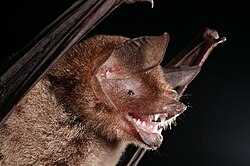Horseshoe bat
Rhinolophidae is a family of bats commonly known as horseshoe bats. There is also an extinct genus of bats, Palaeonycteris. Horseshoe bats are closely related to the Hipposideridae. Horseshoe bats are divided into six subgenera and many species groups. The common ancestor of all horseshoe bats lived 34–40 million years ago. Horseshoe bats are found mostly in tropical or subtropical areas, including Africa, Asia, Europe, and Oceania.
| Horseshoe bats | |
|---|---|

| |
| Lesser horseshoe bat (Rhinolophus hipposideros) with blue metallic identification band on left wing | |
| Scientific classification | |
| Kingdom: | Animalia |
| Phylum: | Chordata |
| Class: | Mammalia |
| Order: | Chiroptera |
| Family: | Rhinolophidae Gray, 1825 |
| Subfamily: | Rhinolophinae Gray, 1825 |
| Genus: | Rhinolophus Lacépède, 1799 |
| Type species | |
| Vespertilio ferrum-equinum Schreber, 1774
| |
| Species | |
Horseshoe bats are a source of disease. Several species are the source of SARS coronavirus. Some evidence suggests that some species could be the source of SARS-CoV-2, which causes coronavirus disease 2019. The bats are hunted for food in several regions, particularly Sub-Saharan Africa, but also Southeast Asia. Some species or their guano are used in traditional medicine in Nepal, India, Vietnam, and Senegal.
Description
Horseshoe bats are a small to medium-sized microbat. They weigh 4–28 g (0.14–0.99 oz), with their forearms being 30–75 mm (1.2–3.0 in) in length. Their combined head and body lengths is 35–110 mm (1.4–4.3 in). Their fur can be reddish-brown, blackish, or bright orange-red, with a majority of species having long, smooth fur.
They have large wings compared to their size, and the shape of the wings means they are able to make quick, tight turns at slow speeds.[1](p361)
They get their common name from their large noses (nose-leafs), which are shaped like horseshoes. The nose-leafs help with echolocation; the bats use their nose to make a constant frequency, high-duty call to find their prey. They hunt insects and spiders. Little is known about their mating systems, but at least one species is monogamous, while another is polygynous. Gestation is about seven weeks and one baby is produced at a time. Bats live for six or seven years, but one greater horseshoe bat lived more than 30 years.
Some species of bats are solitary, and roost alone, while others live in groups of several thousand.[2](p xi)
Horseshoe Bat Media
Upper and lower maxilla of the Lower Miocene fossil horseshoe bat, Palaeonycteris robustus
WOE 92 Mariana Fruit Bat, Pteropus mariannus mariannusEnglish Wikipedia, original upload 18 August 2005 by ZeWrestler and edited and reuploaded by Fir0002 (there's one brighter version at en:Image:Mariana Fruit Bat.jpg)
Lesser Mouse- tailed Bat (Rhinopoma hardwickii) 2
- Craseonycteris thonglongyai.png
Craseonycteris thonglongyai
- Rhinonicteris aurantia.jpg
Orange leaf-nosed bat, Rhinonicteris aurantia
- Hipposideros gigas.jpg
Giant roundleaf bat, Hipposideros gigas; photograph
- Rhinolophus rouxii.jpg
Rufous Horseshoe Bat (Rhinolophus rouxii)
References
- ↑ Norberg, U. M.; Rayner, J. M. V. (1987). "Ecological morphology and flight in bats (Mammalia; Chiroptera): Wing adaptations, flight performance, foraging strategy and echolocation". Philosophical Transactions of the Royal Society of London B, Biological Sciences. 316 (1179): 335–427. Bibcode:1987RSPTB.316..335N. doi:10.1098/rstb.1987.0030.
- ↑ Csorba, G.; Ujhelyi, P.; Thomas, P. (2003). Horseshoe Bats of the World: (Chiroptera: Rhinolophidae). Alana Books. ISBN 9780953604913.



